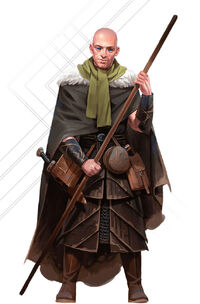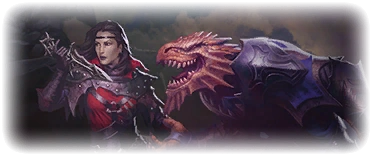A warlock was an arcane spellcaster who gained power through pacts with powerful entities, most commonly devils, elder evils of the Far Realm, fey,[7] or demons.[8] These pacts allowed warlocks to channel powerful abilities of arcane might that would otherwise be closed to them.[1] Those abilities weren't limited to those striking pacts with magical entities. Some were born with them because they belonged to a powerful magical bloodline and those who mastered that power were also called warlocks.[9]
Culture[]
Warlocks had an overall poor reputation, a result of their dealings with otherworldly and often malevolent outsiders. However, not all warlocks were evil, and many used their deadly gifts for benign purposes, but even so, they were regarded with skepticism.[12][13] How far the warlock went to fulfilling their pact was entirely up to them,[12] though corruption was an ever-present danger for warlocks of all stripes. Likewise, many warlocks made pacts with several creatures, rather than just one, in order to access even more power,[14] though all warlocks eventually favored one pact over all the others[15] lest their patrons take offense.[13]
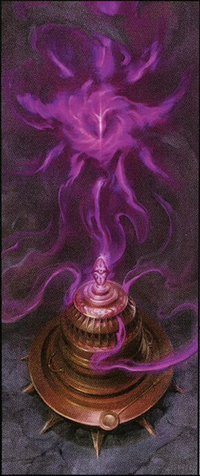
Some warlocks' powers came from dark and ancient sources.
Like sorcerers, many warlocks came from a supernatural bloodline, and it had been said that warlocks were "born, not made." This was not true for all warlocks, though many did indeed come from fey or fiendish bloodlines.[13][9] Those that weren't were still often touched by destiny in some special way, sought out by powerful extraplanar forces as tools and minions, altering their souls and giving them supernatural abilities beyond the ken of most mortals.[9] These forces beheld warlocks to their power, though some broke away from the chains of their servitude to forge their own destiny. More often, warlocks, by choice or by circumstance, became much like the cruel and capricious beings they served.[16] Regardless of how they treated their patrons, most warlocks had a healthy respect for the divine, particularly patrons of magical power such as Corellon or Selûne, though many evil warlocks were drawn to Asmodeus and Cyric as well.[17] There were exceptions, however. Some warlocks sought out good gods deliberately to counter the powerful temptations they dealt with regularly.[16] Other warlocks felt no ties to the gods, perhaps due to their frequent dealings with other supernatural powers.
Tieflings and others of fiendish blood were powerfully drawn to the ways of the warlock and were among the most common to take the path. Humans, thanks in large part to their capacity for ambition, also bred many warlocks, hoping to find a path to power that did not take them a significant portion of their short lifespans. Half-orcs were also commonly warlocks, in part because the powers that chose to give patronage to warlocks did not discriminate between them and other, more "purebred", races.[18] Other planetouched, particularly fey'ri, genasi, and worghests,[19] but celadrin, as well as shadar-kai and star elves, were also often drawn to forge warlock pacts, the latter due in part to the chaotic and troubled energies which filled Sildëyuir.[9] Warlocks from other races were far more rare,[18] though halflings and half-elves, when given the incentive, made excellent practitioners of the dark arts.[17]
Warlocks had varying views of those who differ from them, in part because of their outsider place in society. Generally, warlocks viewed other arcane spellcasters through a lens of bitter rivalry,[18] and likewise wizards tended to view warlocks as those who tainted the reputation of the Art.[13] Warlocks generally had a healthy respect for fighters' strength or rogues' cleverness, but few got along well with practitioners of divine magic, in part due to their dealings with unholy powers. Even so, warlocks rarely tried to deliberately upset allies who could have proven useful, which included clerics.[18]
Abilities[]
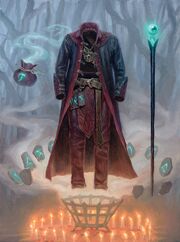
A warlock's typical gear.
Warlock spells were also called invocations, which were released through sheer force of will rather than by trained practice or innate ability.[20] Invocations tended to be more powerful and deadly than those of a wizard or sorcerer, though had limited range or area of effect. Some invocations were less inherently deadly but instilled terror or confusion in an enemy, and warlocks were adept in cursing those with whom they fought. The most basic of all invocations was called an eldritch blast and was essentially a charged blast of pure arcane energy.[21] When forced into combat, experienced warlocks often eluded enemy blows through spells of flying, teleportation, or invisibility.[12]
As a result of their pacts, warlocks channeled arcane power with more ease than most other arcane spellcasters, though this power was most particularly focused around a warlock's pact. Prior to the Spellplague, this difference in the acquisition of magical power made warlocks intrinsically different than their fellow casters. Unlike other arcane spellcasters, warlocks were not limited to a number of spells per day, but instead could unleash each of their powers as often as they wanted, though at the cost of versatility.[20] This changed with the Spellplague, after which warlocks became more similar to other arcane spellcasters in their casting methods.[4][1]
Warlocks had some degree of training in the use of basic weapons and leather armor, which gave them a slight edge over both wizards and sorcerers in non-magical battle, though still left them vulnerable to the attacks of more specialized combatants. For the most part, warlocks, like other arcane spellcasters, relied on their magic as both a shield and a weapon, and the tools a warlock was most likely to use was his or her implements. For this purpose most warlocks used rods or wands, though specialized weapons, a pact blade being the most common, could sometimes be used by highly experienced warlocks to enhance their invocations.[22]
Several warlocks learned additional abilities to help them. From their ties to dark powers, some warlocks gained resistance to cold iron over time. Others learned to make their bodies more resilient, healing more quickly through their fiendish power, sometimes at extraordinary rates. Similarly, many warlocks acquired resistance to various energy types, particularly attacks that used acid, cold, electricity, fire, or psionic energy as a major component. Lastly, some warlocks became so full of arcane power that they were able to literally imbue mundane items with their power at a whim, creating magical items of great value, even if they did not possess the knowledge typically necessary to create such an item.[23]
Pact Boons[]
Warlocks were apt to receive gifts from their patrons in exchange for or expectation of loyal service. In some cases, these were potent or hexing abilities determined by the patron[17] while other times a warlock might get to choose a gift, and such a choice could come to define the nature of the warlock's pact. The primary gift options offered to warlocks were the Pact of the Chain, in which the warlock was granted the ability to summon a familiar; the Pact of the Blade, in which they gained the ability to summon and shape a pact weapon; and the Pact of the Tome, in which they were bestowed a grimoire known as a Book of Shadows containing additional spells.[1]
Eldritch Invocations[]
Another gift bestowed to Warlocks from their patrons were Eldritch Invocations, fragments of forbidden knowledge with a wide variety of effects from granting the Warlock access to new spells they would not normally have access to (and for some, the ability to cast them with unlimited frequency instead of a limited number of uses per day), improving their aptitude with their Pact Boon in various ways, and multiple different methods of enhancing the eldritch blast spell to a level far beyond what other spellcasters could normally achieve. Vastly improved range, damage, and the ability to knock-back or pull opponents have all been witnessed in the eldritch blasts of a warlock.[1]
Warlock Pacts[]
The attributes and qualities of a warlock were largely determined by the kind of being with whom they have made their primary pact. The following were the known examples of warlock pacts.
Celestial Pact[]
While many warlocks forged pacts with powers of the Lower planes, some preferred to bargain with the benevolent entities of the upper planes.[24] They were touched by the holy energy of powerful celestial beings and their personalities reflected as such. Warlocks with celestial patrons were often driven to rid the world of undead or other fiendish beings, or possessed intense longing to travel to their patron's home within the heavens.[2]
The magic they wielded was a shining reflection of what was possessed by their patron. Celestial warlocks gained access to powerful restorative spells along with others that allowed them to annihilate the forces of darkness. Over time, they bond with their patron allowed them to channel positive energy through their bodies and bolster their life force. Even the threat of impending death could not keep a celestial pact warlock from acting as a mortal conduit for the powers above.[2]
Dark Pact[]
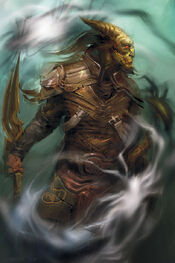
A warlock who dealt with powers of the drow.
Dark pact warlocks forged some of the most dangerous pacts of all, both morally and physically, through foul alliances with Lolth and other entities of drow civilization. It is this latter connection from which the dark pact gained its name and much of its tradition. Those drow that did not choose the path of the wizard or the fighter took on the role of the warlock. In spite of its roots amongst the xenophobic drow, this tradition of dealing with the dark forces of the Underdark slowly moved towards the surface world.[25]
These warlocks gained powers reflecting the pain, poison, and madness inherent in the Underdark. Dark pact warlocks were also granted a boon known as a darkspiral aura, which enabled them to feed off death in battle to create more and more powerful eldritch spells. Invocations of the dark pact were almost always fueled by the strong willpower required of such warlocks. The most basic spell of the dark pact warlock was spiteful glamor, which allowed the warlock to strike into the mind of his or her foe, wracking them with terrible pain.[25]
Truly powerful dark pact warlocks may have become darkwalkers, who immersed themselves so fully in the dark forces with whom they bargained that they became ghostlike and insubstantial.[26]
Fey Pact, the Archfey[]
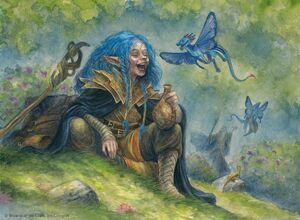
Fey pact warlocks were often more whimsical and playful rather than grim and edgy.
Fey pact warlocks, which were among the fewest in number of all warlocks[9], forewent the obvious dangers of dealing with devils or the forbidding mystery that surrounds the star pact but instead dealt with powerful, supernatural forces of the Feywild. Such spirits of the natural world may have been menacing or simply capricious in their dealings with mortals of the Prime Material Plane. Some were faerie-like dryads or sylphs while others were less easily defined, more like incarnations of nature than anything else.[17] Many of the sponsors of warlocks who sought the fey pact were dangerous archfey, such as the Queen of Air and Darkness or other such Unseelie fey,[9]
The magic bestowed upon fey pact warlocks could be enchanting, while retaining the savage lethality common to the Feywild.[17] Typical spells may have charmed a foe or burnt them alive, reflecting the often fickle nature of the fey.[27] Often such invocations required the wielder to have a high level of natural presence and charm, with which they could hold their own in negotiations with the wily and often deceptive beings. The most basic of these, known to all of the fey pacts, was eyebite, which caused its victim to lose sight of their attacker under the weight of staggering psychic pain. Fey patrons were also known to bestow a boon to their warlocks which allowed them to use an ability similar to misty step.[28] Additionally, fey pact warlocks with a measure of fey blood may also have demonstrated a natural affinity for flora and fauna, allowing them to have located hidden wildlife with relative ease.[19]
Warlocks who focused all their attention on dealing with fey spirits might have become one of the feytouched, half-mad spellcasters who slipped between the Feywild and the Prime Material Plane as they wished.[29] Some of the best-known organizations of fey pact warlock included the Lakh-Myr Thorns, who, during the Era of Upheaval, were headed by a shadar-kai named Gaen Ral, as well as the Tairemgira of Kryptgarden Forest. While most fey pact warlocks sided with the Unseelie, a few came under the patronage of more benevolent beings, such as the archfey Titania.[19]
Hexblade Pact[]
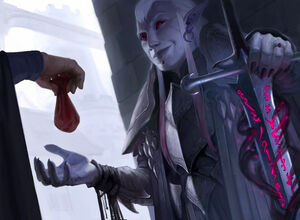
A drow hexblade hiring themself out as a mercenary.
Hexblade warlocks forged pacts with an obscure entity of the Shadowfell. It was speculated by sages that this unknown power was in fact the Raven Queen, as she had made the first of their weapons and thus all hexblade warlocks and their weapons were in her service. Either way, this entity manifested as a sentient weapon made of shadowstuff—Blackrazor was the most notorious of these—and made promises of power to those with whom it would enter into pacts. Many hexblade warlocks of the Prime Material plane forged their own weapons based on this shady blade, while others more simply incorporated shadowy magic into their own arcane powers.[2]
All hexblades learned how to properly arm themselves for war, channeling the shadowy power of their patron into their chosen weapon. They developed the means to curse their foes, making them weaker and more vulnerable to harm. Over time, these warlocks learned how to cull the spirits of those they slew, and transfer the curse from their corpse to another unfortunate soul.[2]
Infernal Pact, the Fiend[]
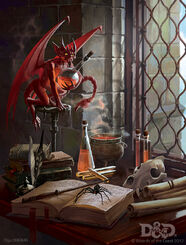
A warlock's imp familiar.
Warlocks of the infernal pact, the most commonly sworn of all the pacts,[9] were those who forged dealings with powerful fiends from the Lower Planes.[1] Such was the ubiquity of this arrangement that the term "warlock" in Faerun was almost synonymous with infernal power.[3] The majority of those who made such pacts were evil, but some rare exceptions[9] strove against the wicked aims of their patron even as their fiendish benefactor sought their own corruption or destruction.[1] Some warlocks of the infernal pact sought forbidden knowledge given to the mortal world by devils but since forgotten over time.[17]
A wide variety of fiendish beings could offer infernal pacts ranging from mere cambions to powerful embodiments of evil like pit fiends, balors, and ultroloths.[3][note 1] Such pacts were not always struck directly or knowingly, as fiendish patrons were known to work through intermediaries.[3] Of all the fiendish pacts, the most common and the representative majority among warlocks were those made with archdevils. No likely patrons were as enthusiastic about making them, for they enjoyed corrupting and controlling the mortals of Faerun.[9]
The most frequent provider of pacts to tiefling and half-fiend warlocks, even before his rise to true divinity, was Asmodeus, Lord of the Nine Hells. He spent a great effort maintaining pacts, and thus influence on other planes, for it allowed him to cement his position as the greatest of the archdevils. Contesting Asmodeus in the frequency of pact-making and for control of these mortals was Mephistopheles, his chief rival. After them, the most frequent employer of the infernal pact was Glasya, Asmodeus's daughter.[9] Most archdevils (the stronger dukes of Hell included) made some pacts, including the likes of Dispater, Belial, and the archdevil turned demigod Gargauth. Demon lords of the Abyss also granted infernal pacts, such as Demogorgon, Orcus, Baphomet, Fraz-Urb'luu, or Eltab. There were also yugoloth lords, such as the fallen solar Malkizid who would do so.[3][1]
These warlocks may have lost much from their bargains with fiends, but gained great power in return. Warlocks wielding the powers of the Nine Hells could turn the life force of enemies against them, and even master the fires of Hell for their own purposes.[27] They were frequently bestowed with the ability to cast hellish rebuke, and infernal patrons were known to bestow a boon to their warlocks which allowed them to steal the vitality of slain enemy.[7] They gained supernatural resilience to the elements over time and learned how to launch their foes through the Lower Planes, fracturing their psyche in the process.[1] Additionally, warlocks with fiendish heritage found that their spells were unusually effective against celestials or other truly good creatures.[9] Some of the most powerful warlocks who truly devoted themselves to their pacts could become life-stealers, vampiric warlocks for whom souls become weapons of war and tools to use.[31]
Star Pact, the Great Old One[]
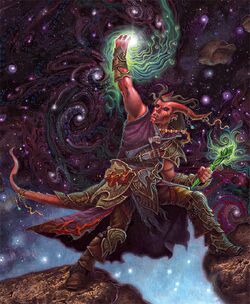
A warlock who forged a pact with an elder evil.
So-called star pact warlocks forged their arcane alliances with the unknowable and alien forces, generally those of the Far Realm.[7] Star pact warlocks often formed these deals without a direct connection, interacting with the elder evils through the intermediary of ancient stars of the void, having learned the secret names of those celestial objects that acted as doorways into the Far Realm.[32]
In some cases, star pact warlocks were unaware of how strongly these stars were connected to the dark powers of the Far Realm and were guided to their pact through haunting nightmares. Such warlocks might have viewed the source of their powers as innocent or at the very least under their control. Others were fully aware of the connection and exploited it anyway, either due to insanity or sheer ambition. Still others viewed these pacts, if they were even aware of them, with an even higher degree of suspicion than normal warlocks warranted, since the aberrant powers of the Far Realm were more horrific than any devil or fey spirit.[32]
Regardless of their motivations or even awareness about the nature of their powers, star pact warlocks gained much from such alliances, including degrees of prescience and powerful spells infused with radiant energy that inspired fear in the warlock's enemies. The most basic of these invocations was dire radiance, which caused a piercing ray of life to burn a warlock’s enemy with pain and fear. Eldritch patrons were also known to bestow a boon on their warlocks which allowed them to glimpse the future by cursing and harnessing the life energy of others.[14]
Experienced warlocks of the star pact could became doomsayers, who spread fear through their powerful magic,[33] or students of Caiphon, apostles of the powerful elder evil that spoke through the ancient star. Star warlocks who continued this path may have become a radiant one, beings who mastered the power of the Far Realm and became aberrations.[32]
Undying Pact, the Undying[]
Warlocks of the undying pact formed a union with some eternal being that had achieved immortality during their mortal life. Some of the well-known undying pact patrons in Faerûn included Larloch, the lich who was referred to as the Shadow King and Gilgeam, the returned God-King of Unther.[34]
These warlocks were able to cast away the needs of their mortal body and slow the effects of aging. They became partially indestructible by physical means, and could readily restore any limbs that may have become unattached.[35]
Other Pacts[]
Details of other pacts are sparse but it was known that some warlocks have been found in the service of other lords. For instance, during the Era of Upheaval, a number of genasi warlocks found their way into the service of a fire elemental known as Sthes'kthes. Although unlikely to be bound of Hanali Celanil by pact, some celadrin warlocks had also been known to serve the goddess as clerics and eldritch theurges. Additionally, a number of worghest warlocks were at one time bound to the barghest Tarkomang as his servants.[19]
Warlock Traditions[]
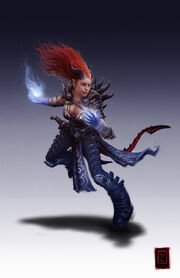
A tiefling warlock.
Deceptive Warlocks[]
Deceptive warlocks preferred guile to sheer power and typically trained themselves in spells that may have been less immediately lethal, but which could cause any number of unpleasant side effects. For this reason, deceptive warlocks were less likely to be found in the thick of the fighting, using long-range invocations instead. These warlocks often had a very strong force of personality, which they channeled into their spells for additional power. Many were also highly intelligent, cunning which allowed them to often use their invocations in more effective ways. Deceptive warlocks were most likely to hold themselves to powerful archfey or aberrations.[17]
Scourge Warlocks[]
Preferring raw power to subtlety, scourge warlocks were tougher than the average warlock, possessing a powerful constitution, which often superseded their intellect and charisma. Scourge warlocks fostered this capacity for endurance purposefully, channeling their vitality into the deadly invocations they wielded. This came at the cost of often endangering oneself, either in close combat or through the sheer lethality of their powers, but scourge warlocks were typically more than capable of wielding their dangerous spells safely. Most scourge warlocks were beholden to devils or horrors of the Far Realm, though exceptions existed.[17]
Notable Warlocks[]
Individuals[]
- Ammon Jerro, a powerful warlock from Neverwinter that dedicated himself to opposing the King of Shadows.[36]
- Farideh, an adventurer and descendent of Bryseis Kakistos.[37]
- Japheth Donard, a fey pact warlock[38] that drew his power from the archfey Neifion.[39]
Organizations[]
- Luminaries, a religious sect of the Warlock Knights of Vaasa that drew their power from the imprisoned primordial Telos.[40][41]
- Nishaadhri, the Vaasan spellcasters that served the realm's famous Warlock Knights, who also drew their power from Telos.[40]
- Toril thirteen, the group of tiefling warlocks that famously forged a pact with the archdevil-turned-deity Asmodeus.[37]
Appendix[]
Notes[]
- ↑ The 4th edition Player's Handbook limited warlocks to take patrons only from the Nine Hells and not from the Abyss. The 5th edition Player's Handbook expanded this to include the entirety of the Lower Planes. In addition to their thematic similarities, the two iterations include the shared ability 'Dark One's Blessing'. While the term "infernal" refers only the devilish concerns originating from the Nine Hells, for the purposes of this article the 'Infernal Pact' is considered relatively synonymous with 'the Fiend' warlock patron.
Appearances[]
- Novels
- Abolethic Sovereignty (Plague of Spells, City of Torment) • Brimstone Angels series (Brimstone Angels, Lesser Evils, The Adversary, Fire in the Blood, Ashes of the Tyrant, The Devil You Know)
- Video Games
- Neverwinter Nights 2 • Idle Champions of the Forgotten Realms • Neverwinter • Baldur's Gate III
External links[]
Disclaimer: The views expressed in the following links do not necessarily represent the views of the editors of this wiki, nor does any lore presented necessarily adhere to established canon.
 Warlock article at the Baldur's Gate 3 Community Wiki, a community wiki for Baldur's Gate 3.
Warlock article at the Baldur's Gate 3 Community Wiki, a community wiki for Baldur's Gate 3.
References[]
- ↑ 1.0 1.1 1.2 1.3 1.4 1.5 1.6 1.7 1.8 Mike Mearls, Jeremy Crawford (2014). Player's Handbook 5th edition. (Wizards of the Coast), pp. 108–111. ISBN 978-0-7869-6560-1.
- ↑ 2.0 2.1 2.2 2.3 2.4 Jeremy Crawford, Mike Mearls, Robert J. Schwalb, Adam Lee, Christopher Perkins, Matt Sernett (November 2017). Xanathar's Guide to Everything. Edited by Kim Mohan. (Wizards of the Coast), pp. 53–57. ISBN 978-0-7869-6612-7.
- ↑ 3.0 3.1 3.2 3.3 3.4 Steve Kenson, et al. (November 2015). Sword Coast Adventurer's Guide. Edited by Kim Mohan. (Wizards of the Coast), pp. 138–140. ISBN 978-0-7869-6580-9.
- ↑ 4.0 4.1 Rob Heinsoo, Andy Collins, James Wyatt (June 2008). Player's Handbook 4th edition. (Wizards of the Coast), pp. 130–142. ISBN 0-7869-4867-1.
- ↑ Rob Heinsoo, Logan Bonner, Robert J. Schwalb (September 2008). Forgotten Realms Player's Guide. (Wizards of the Coast), pp. 49, 54. ISBN 978-0-7869-4929-8.
- ↑ Richard Baker (November 2004). Complete Arcane. (Wizards of the Coast), pp. 5–10. ISBN 0-7869-3435-2.
- ↑ 7.0 7.1 7.2 Rob Heinsoo, Andy Collins, James Wyatt (June 2008). Player's Handbook 4th edition. (Wizards of the Coast), pp. 130–131. ISBN 0-7869-4867-1.
- ↑ Rob Heinsoo, Logan Bonner, Robert J. Schwalb (September 2008). Forgotten Realms Player's Guide. (Wizards of the Coast), p. 35. ISBN 978-0-7869-4929-8.
- ↑ 9.00 9.01 9.02 9.03 9.04 9.05 9.06 9.07 9.08 9.09 9.10 Eytan Bernstein (2007-03-14). Warlocks, Part 1. Class Chronicles. Wizards of the Coast. Archived from the original on 2016-10-31. Retrieved on 2018-12-08.
- ↑ Erin M. Evans (December 2013). The Adversary. (Wizards of the Coast), p. 25. ISBN 0786963751.
- ↑ Larian Studios (October 2020). Designed by Swen Vincke, et al. Baldur's Gate III. Larian Studios.
- ↑ 12.0 12.1 12.2 Rob Heinsoo, Andy Collins, James Wyatt (June 2008). Player's Handbook 4th edition. (Wizards of the Coast), p. 129. ISBN 0-7869-4867-1.
- ↑ 13.0 13.1 13.2 13.3 Steve Kenson, et al. (November 2015). Sword Coast Adventurer's Guide. Edited by Kim Mohan. (Wizards of the Coast), p. 138. ISBN 978-0-7869-6580-9.
- ↑ 14.0 14.1 Rob Heinsoo, Andy Collins, James Wyatt (June 2008). Player's Handbook 4th edition. (Wizards of the Coast), p. 131. ISBN 0-7869-4867-1.
- ↑ Rob Heinsoo, Andy Collins, James Wyatt (June 2008). Player's Handbook 4th edition. (Wizards of the Coast), pp. 129–130. ISBN 0-7869-4867-1.
- ↑ 16.0 16.1 Richard Baker (November 2004). Complete Arcane. (Wizards of the Coast), pp. 5–6. ISBN 0-7869-3435-2.
- ↑ 17.0 17.1 17.2 17.3 17.4 17.5 17.6 17.7 Rob Heinsoo, Andy Collins, James Wyatt (June 2008). Player's Handbook 4th edition. (Wizards of the Coast), p. 130. ISBN 0-7869-4867-1.
- ↑ 18.0 18.1 18.2 18.3 Richard Baker (November 2004). Complete Arcane. (Wizards of the Coast), p. 6. ISBN 0-7869-3435-2.
- ↑ 19.0 19.1 19.2 19.3 Eytan Bernstein (2007-03-14). Warlocks, Part 1. Class Chronicles. Wizards of the Coast. Archived from the original on 2016-10-31. Retrieved on 2018-12-08.
- ↑ 20.0 20.1 Richard Baker (November 2004). Complete Arcane. (Wizards of the Coast), p. 5. ISBN 0-7869-3435-2.
- ↑ Rob Heinsoo, Andy Collins, James Wyatt (June 2008). Player's Handbook 4th edition. (Wizards of the Coast), p. 132. ISBN 0-7869-4867-1.
- ↑ Rob Heinsoo, Andy Collins, James Wyatt (June 2008). Player's Handbook 4th edition. (Wizards of the Coast), pp. 129–131. ISBN 0-7869-4867-1.
- ↑ Richard Baker (November 2004). Complete Arcane. (Wizards of the Coast), p. 8. ISBN 0-7869-3435-2.
- ↑ Jerry Holkins, Elyssa Grant, Scott Fitzgerald Gray (June 18, 2019). Acquisitions Incorporated. Edited by Scott Fitzgerald Gray. (Wizards of the Coast), p. 70. ISBN 978-0786966905.
- ↑ 25.0 25.1 Rob Heinsoo, Logan Bonner, Robert J. Schwalb (September 2008). Forgotten Realms Player's Guide. (Wizards of the Coast), pp. 35–40. ISBN 978-0-7869-4929-8.
- ↑ Rob Heinsoo, Logan Bonner, Robert J. Schwalb (September 2008). Forgotten Realms Player's Guide. (Wizards of the Coast), p. 49. ISBN 978-0-7869-4929-8.
- ↑ 27.0 27.1 Rob Heinsoo, Andy Collins, James Wyatt (June 2008). Player's Handbook 4th edition. (Wizards of the Coast), pp. 132–140. ISBN 0-7869-4867-1.
- ↑ Rob Heinsoo, Andy Collins, James Wyatt (June 2008). Player's Handbook 4th edition. (Wizards of the Coast), pp. 131–132. ISBN 0-7869-4867-1.
- ↑ Rob Heinsoo, Andy Collins, James Wyatt (June 2008). Player's Handbook 4th edition. (Wizards of the Coast), p. 141. ISBN 0-7869-4867-1.
- ↑ Magic: The Gathering (July 2021).
AFR #221 "Farideh, Devil's Chosen", illus. Magali Villeneuve. Wizards of the Coast.
- ↑ Rob Heinsoo, Andy Collins, James Wyatt (June 2008). Player's Handbook 4th edition. (Wizards of the Coast), p. 142. ISBN 0-7869-4867-1.
- ↑ 32.0 32.1 32.2 Bruce R. Cordell (August 2008). “Wish Upon a Star”. In Chris Youngs ed. Dragon #366 (Wizards of the Coast), pp. 17–25.
- ↑ Rob Heinsoo, Andy Collins, James Wyatt (June 2008). Player's Handbook 4th edition. (Wizards of the Coast), p. 140. ISBN 0-7869-4867-1.
- ↑ Steve Kenson, et al. (November 2015). Sword Coast Adventurer's Guide. Edited by Kim Mohan. (Wizards of the Coast), p. 139. ISBN 978-0-7869-6580-9.
- ↑ Steve Kenson, et al. (November 2015). Sword Coast Adventurer's Guide. Edited by Kim Mohan. (Wizards of the Coast), p. 140. ISBN 978-0-7869-6580-9.
- ↑ Obsidian Entertainment (October 2006). Designed by Ferret Baudoin, J.E. Sawyer. Neverwinter Nights 2. Atari.
- ↑ 37.0 37.1 Erin M. Evans (December 2013). The Adversary. (Wizards of the Coast), p. 10. ISBN 0786963751.
- ↑ Bruce R. Cordell (2009). City of Torment. (Wizards of the Coast), p. 2. ISBN 978-07869-5184-0.
- ↑ Bruce R. Cordell (2009). City of Torment. (Wizards of the Coast), p. 79. ISBN 978-07869-5184-0.
- ↑ 40.0 40.1 Brian R. James (April 2010). “Realmslore: Vaasa”. In Chris Youngs ed. Dungeon #177 (Wizards of the Coast) (177)., p. 78.
- ↑ Bruce R. Cordell, Ed Greenwood, Chris Sims (August 2008). Forgotten Realms Campaign Guide. Edited by Jennifer Clarke Wilkes, et al. (Wizards of the Coast), p. 276. ISBN 978-0-7869-4924-3.


